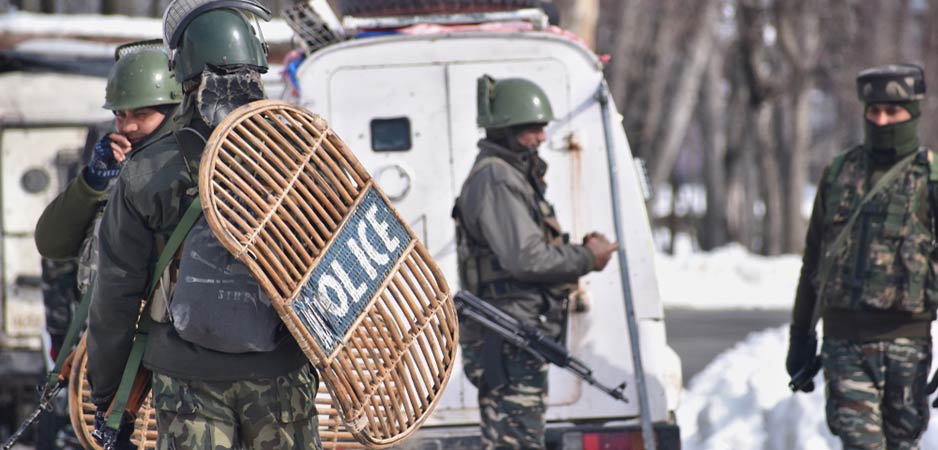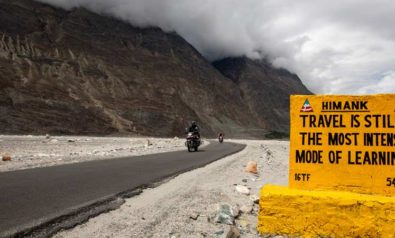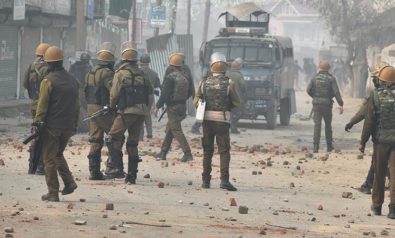Four months after India’s abrogation of Article 370 in the state of Jammu and Kashmir, different reports on the situation have emerged from national and international media. Indian media have focused on the return of normalcy in the region with limited mention of the human rights violations taking place. International media have primarily looked at the human rights situation with little mention of the preexisting security situation.
360° Context: Kashmir Explained — Why India and Pakistan Fight Over It
While there is no denying the occurrence of human rights violations in Kashmir, including a communications lockdown, a curfew and the detainment of political leaders, there has been a lack of discussion about the volatile, historical context in the state and the genuine reasons for India’s undeniably disturbing lockdown.
Firstly, the crucial fact that Article 370 was a temporary provision granting special autonomous status to Jammu and Kashmir in the Indian Constitution has rarely found mention. India has not attempted to redraw any external boundaries. It has merely removed a complex and temporary article within its own constitution.
Since August 5, India has stressed that its objective is to increase economic investment and development in Jammu and Kashmir and to integrate the state into the rest of India. Prime Minister Narendra Modi has also promised that Jammu and Kashmir will not remain a union territory for long and its statehood will be restored at some point in the future. Meanwhile, Pakistani Prime Minister Imran Khan’s loose, absurd and disturbing talk of genocide in Kashmir, all whilst ironically refusing to recognize the state of Israel and fueling anti-Semitic sentiment, only brings serious dishonor to victims of genocide. The means can be rightfully questioned, but the move by India with its consistent language of development and progress at least appears well-intentioned.
A Diverse State
International media have not adequately explained the complex demography and diversity of the region. Muslim-majority Kashmir makes up only 15% of the state of Jammu and Kashmir, yet it comprises 53.9% of the population. The rest of the population is Hindu or Buddhist Ladakhi.
It is hypocritical when global media outlets unabashedly, yet understandably, criticize alleged majoritarianism in Modi’s India but apply a majoritarian lens to view Jammu and Kashmir. As Atul Singh and Manu Sharma state in an article on Fair Observer, there is often little mention of the ethnic cleansing and mass exodus of Kashmiri Pandits who, in the 1990s, were driven out of their homes in fear of persecution. This is also the case with Buddhist Ladakhis who have faced systematic discrimination by Kashmiri Muslims. Hindus and Buddhist Ladakhis have thus celebrated the removal of Article 370, as well as the decision to divide the state into the two union territories of Jammu and Kashmir as well as Ladakh to allow for more effective administration and governance based on the individual needs of the territories.
The removal of Article 370 also allows for the application of laws focused on the rights of minorities and women in Jammu and Kashmir. The region’s special status previously had allowed it to retain its own laws, many of which were discriminatory to women and minorities. For instance, if a woman from Jammu and Kashmir married a man from another state, she lost the right to own property there. The same did not apply to a male resident of the state who married someone from outside.
A well-known case is that of Charu WaliKhanna, a Kashmiri Hindu lawyer, who was forced to flee the state and later wanted to purchase a home there but couldn’t because she was no longer a permanent resident and was married to a non-Kashmiri. Along with another Kashmiri woman who was a permanent resident but married to a non-resident, WaliKhanna filed petitions and challenged these laws in 2017 on the grounds that they were counter to India’s inheritance laws, which grant women equal rights.
The Lockdown of Kashmir
With regard to the lockdown in Kashmir, a country like India with its largely benign and responsible image on the global stage will hardly risk damaging it with unnecessary actions. The crackdown was not conducted out of the blue, but rather due to longstanding security risks in the state.
During a recent US congressional hearing on human rights, Alice Wells, the US assistant secretary of state for South and Central Asia, repeatedly used the word “terrorists” and mentioned how activities across the Line of Control — the boundary separating Indian-controlled and Pakistani-controlled Kashmir — have fermented violence and destabilization, thereby emphasizing that cross-border terrorism has been central to Kashmir. Wells used language that big global media outlets like the BBC, Al Jazeera and The New York Times do not use in the Indian context. Historically, they often refrain from using the term “terrorists” when attacks occur in India, including Mumbai in 2008. Instead, these outlets describe attackers as “militants” and/or “fighters.”
Although the lockdown and curfew have been gradually lifted, it is primarily the internet clampdown that is still ongoing. This is due to the risk of Pakistani terrorist groups and Kashmiri militants weaponizing the internet to mobilize people and foment unrest.
That the internet can be easily mobilized, manipulated and misused in the hands of the wrong people hardly needs a mention. In 2016, after militant Burhan Wani, commander of Hizb-ul Mujahideen, was killed in an encounter with Indian security forces, the exploitation of social media by online groups to capitalize on the situation led to one of the most violent periods in the history of Kashmir. As Parjanya Bhatt of the Observer Research Foundation writes, “[S]ocial media strategies in Kashmir have been morphed into a tradition where false narratives create heroes out of fallen terrorists and radicalise new recruits as icons.”
State-Sponsored Terror
But even as India attempts to normalize the situation in Kashmir, militancy is a threat and people are refraining from venturing out and opening their shops due to intimidation. International media outlets consistently focus on the thousands of Indian troops that are deployed in the region, making it the most militarized zone in the world.
Yet the news media rarely focus on India as the principal victim of Pakistani state-sponsored terrorism. The primary reason for the presence of these soldiers is the constant threat of Pakistani terrorists infiltrating and killing civilians in India. Terrorists, some of whom have been neutralized by Indian forces, have killed numerous civilians, including apple traders and migrant laborers. There have also been disturbing reports of Pakistani attempts to smuggle hundreds of terrorists into Kashmir and that, despite the communications lockdown, Pakistan has devised innovative ways of connecting with terrorist groups.
Anyone who understands the nature of the Pakistani state, including its capability for state-sponsored terrorism its policy to “bleed India with a thousand cuts,” knows that the security risk to India will likely persist. Veronica Ekelund, an analyst at the Amsterdam-based think tank EFSAS, has heavily criticized a report by the UN High Commissioner for Human Rights on Jammu and Kashmir for its omission of Pakistani state-sponsored terrorism and its consequences, and for “narrowing the conflict to a two-year period, starting with Burhan Wani’s death in 2016.”
American scholar Christine Fair who has spent decades studying the region has repeatedly pointed out that unless Pakistan cracks down on terrorists operating within its borders, it is impossible for India to sort out its Kashmir problem. The fact that Prime Minister Khan’s ascent to leadership has been engineered by the Pakistan army — the very entity that harbors jihadists against India as part of its decades-long proxy war — does not help.
Transnational Terrorism
Hizb-ul Mujahideen, Lashkar-e-Taiba and Jaish-e-Mohammad are just some of the groups sponsored by Pakistan that operate in the Kashmir Valley. Besides these, there is also the infiltration of transnational terrorist organizations like al-Qaeda and the Islamic State (IS) through their affiliates, such as Ansar Ghazwat-ul Hind and al-Qaeda in the Indian Subcontinent. Rather than azadi (freedom) for Kashmir, these groups want an establish an Islamic caliphate governed by sharia law.
Mohammed Sinan Siyech, a research analyst at the International Centre for Political Violence and Terrorism Research, explains how these ideologies could become more entrenched in Kashmir. In fact, Burhan Wani, the militant that acquired celebrity status after being killed by Indian armed forces in 2016, did not want the state to accede to either India or Pakistan. Instead, his aim, like that of so many other youngsters in Kashmir, was an IS-style caliphate.
In May, IS announced its new province in Kashmir called “Wilayah of Hind.” James M. Dorsey explains how Kashmir is becoming a battleground for Middle Eastern rivals Iran, Saudi Arabia and Turkey. Siddharthya Roy, in an article for The Diplomat, mentions the emergence of the new Islamic State brand of terrorism in Kashmir. This raises questions of the kind of state an independent Kashmir could be. It is clear why India does not want the risk of an Islamic caliphate on its doorstep.
Political Corruption
As if all this was not enough, there have been serious governance issues in Jammu and Kashmir, including endemic corruption by political classes. A study carried out by researcher Ayjaz Wani of the Observer Research Foundation found that for nearly 64% of people in the Kashmir Valley, a lack of governance has been a huge factor that has led to instability and revolts. In a separate article, Wani mentions that “the state witnessed an unending spell of arrested development owing to a sluggish, inefficient and corrupt administration,” which “created pervasive anguish and frustration among the masses, especially the Valley’s youth.”
In August, Home Minister Amit Shah said that 14,255 rupees ($200) per capita was allocated to Jammu and Kashmir compared to over 3,681 rupees per capita for the national average, most of which ended up in the pockets of corrupt, local politicians.
The special status granted to the state by Article 370 exacerbated these problems. As Kashmiri scholar Aijaz Ashraf Wani states, the “governance-deficit has [spurred] the conflict and the conflict has fuelled the governance-deficit.” Whether the detainment of local politicians was necessary certainly warrants questions. But the very least the international media can do is explain the preexisting situation in the state.
Old approaches have not achieved results in Jammu and Kashmir. However questionable its actions may be, India is using a fresh approach to deal with the Kashmir issue by attempting to rid the state of extremist influence and usher in an era of peace and development. The removal of Article 370 allows Indians from other states to invest in Jammu and Kashmir. It also eliminates hindrances that did not allow the region to integrate with the rest of India and instead pushed it into the arms of extremists.
Any reportage on this highly-complex situation without devoting adequate attention to the volatile, preexisting conditions provides a misleading and incomplete picture of India’s actions. News requires context, and stories that detail what is happening but do not pay enough attention to why it is happening is bound to give a skewed view of events. International media coverage has done exactly this: It has failed to contextualize the Kashmir issue and provide a more nuanced and deeper understanding of the situation.
The views expressed in this article are the author’s own and do not necessarily reflect Fair Observer’s editorial policy.
Support Fair Observer
We rely on your support for our independence, diversity and quality.
For more than 10 years, Fair Observer has been free, fair and independent. No billionaire owns us, no advertisers control us. We are a reader-supported nonprofit. Unlike many other publications, we keep our content free for readers regardless of where they live or whether they can afford to pay. We have no paywalls and no ads.
In the post-truth era of fake news, echo chambers and filter bubbles, we publish a plurality of perspectives from around the world. Anyone can publish with us, but everyone goes through a rigorous editorial process. So, you get fact-checked, well-reasoned content instead of noise.
We publish 2,500+ voices from 90+ countries. We also conduct education and training programs
on subjects ranging from digital media and journalism to writing and critical thinking. This
doesn’t come cheap. Servers, editors, trainers and web developers cost
money.
Please consider supporting us on a regular basis as a recurring donor or a
sustaining member.
Will you support FO’s journalism?
We rely on your support for our independence, diversity and quality.










